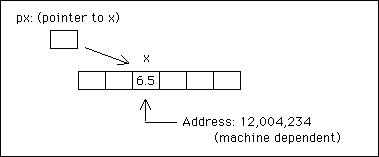Pointers
Sometimes we want to know where a variable resides in memory. A pointer contains the address of a variable that has a specific value. When declaring a pointer, an asterisk is placed immediately before the pointer name.
The address of the memory location where the variable is stored can be found by placing an ampersand in front of the variable name.
int num; /* Normal integer variable */
int *numPtr; /* Pointer to an integer variable */
The following example prints the variable value and the address in memory of that variable.
printf("The value %d is stored at address %X\n",
num, &num);
To assign the address of the variable num to the pointer numPtr, you assign the address of the variable, num, as in the example given next:
numPtr = #
To find out what is stored at the address pointed to by numPtr, the variable needs to be dereferenced. Dereferencing is achieved with the asterisk that the pointer was declared with.
printf("The value %d is stored at address %X\n",
*numPtr, numPtr);
All variables in a program reside in memory. The statements given below request that the compiler reserve 4 bytes of memory on a 32-bit computer for the floating-point variable x, then put the value 6.5 in it.
float x;
x = 6.5;
As the address location in memory of any variable is obtained by placing the operator & before its name therefore &x is the address of x. C allows us to go one stage further and define a variable, called a pointer that contains the address of other variables. Rather we can say that pointer points to other variable. For example:
float x;
float* px;
x = 6.5;
px = &x;
defines px to be a pointer to objects of type float, and sets it equal to the address of x. Thus, *px refers to the value of x:

|


